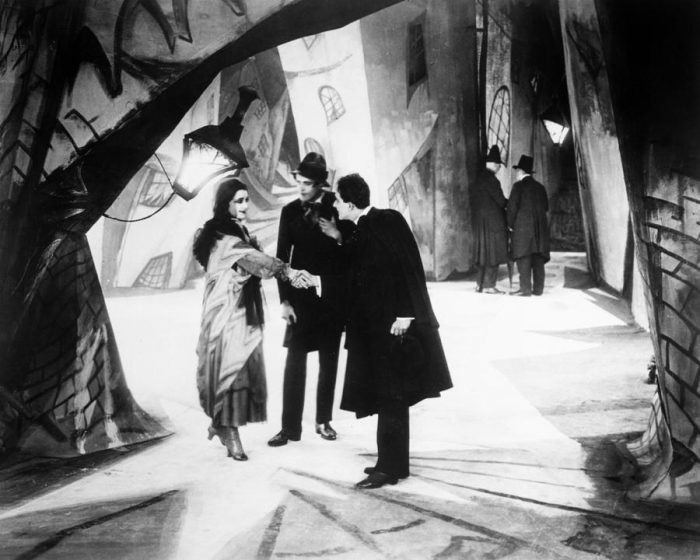
The post-war (WWI) era saw a continued boom in film production and distribution all over the world, from Hollywood to beyond. With the streamlining of both the production and distribution of film, along with the value of film finally being recognized as being a form of media beyond fairground entertainment, film directors were given the chance to explore and execute more daring ways of planning, filming and editing films.
Compared to the early slice-of-life films created by the Lumiere brothers, Dr Caligari (dr. Robert Wiene) presents an odd and almost parallel presentation of the possibilities of portrayal in film: the Lumiere brothers aimed to recreate reality, making it as naturalistic as possible, while Wiene aimed to subvert it, creating a very subjective viewpoint of reality from an individual’s point of view. In fact, the success of Dr Caligari comes directly from how it managed to successfully express one’s internal psyche in a visual way – from that of a mass mob such as that of the German public, down to the exploration of the human’s inner self, something that has never really been explored in cinema before.
The period when Dr Caligari was created was a bleak time for the German public – Germany had just lost WWI with astronomical human and financial losses, leading to sky high inflation and terrible living conditions back at home. Coupled with the horrors of trench warfare experienced in WWI, the general mood of the German people was one shrouded with pessimism and trauma. Instead of providing a rosier alternate reality as a mode of escape from the harsh postwar realities, however, Dr Caligari creates a set and lighting that intentionally shows a twisted, distorted version of reality; the mise-en-scene is done such that the world in Dr Caligari appears to be visually harsh and even menacing. Thus, the expression of the filming is not turning inwards i.e. escapism from harsh postwar realities but rather outwards, openly expressing the sense of desolation and torment Germany faced after the war. The actors’ silhouettes and shadows are intentionally elongated with the carefully prepared lighting, and the set design itself is done expressively rather than naturalistically –rather than shooting the film on scene, an entire set is built, much like a theatrical setup. The landscapes of the set itself are also painted expressively – the buildings are done with no regard for visual perspective and often skewed to create rough, jagged edges and asymmetrical shapes, with streaks of light directly painted onto the set to heighten the dramatic effect. The jagged touch is also reflected in the style of the intertitle cards, with typography that was similarly jagged to contribute to the mood of the film. In a way, this sense of chaos and foreboding in the mise-en-scene of Dr Caligari is reflective of the state of anarchy Germany was in after the war.
At the same time, Dr Caligari presents an interesting exploration into the inner psyche of the individual, especially with the twist ending. With the reveal of the unreliable narrator, an interesting shift is brought into the telling of the story – the perspective of the narrator contributes to narrative itself, and the inner psyche of the narrator is made concrete, affecting the way the audience interprets the narrative itself.
Dr Caligari opens with the introduction of the narrator of the story – we see him telling the story to his companion, with an iris effect (a ring of blackness surrounding a small area) employed to reduce the focus to his face, before shifting and expanding to reveal the landscape in which the story was going to take place. This effect is used multiple times in the introduction, to ensure that the viewer is clear that the narrative of the film was shifting into that of the storyteller. With the reveal of the twist ending, this device becomes even more poignant – the iris effect essentially makes it such that the viewer slowly shifts into the perspective of the (unreliable) narrator, and thus experiences the subjective reality from his (inner) point of view. The set design and mise-en-scene furthers this ambiguity between reality and subjective vision – as mentioned earlier, the set is designed in a non-realistic way, and the lighting is used to emphasise that – low- key lighting is used in many of the scenes to create harsh contrasts and dark tones and shadows, both on the set and the characters, using a Chiaroscuro technique to raise the drama of the scene. This use of lighting also emphasises the makeup used on the actors – most of them having pallid, pale faces with strong dark circles – and the strong lighting casts strong shadows that makes them look more haunting and menacing. The actors also perform in an unnaturalistic manner, with their actions often exaggerated and jerky. Altogether, the mise-en-scene builds up a universe that is similar to but unlike reality, thus continuing the subjective viewpoint of reality from the mad man’s point of view.
Thus, Dr Caligari employs a strong, expressive visual style, attention to mise-en-scene and subtle transitions to build an uncanny world radiating with tension and foreboding, thus being able to convey anxieties and trauma of the German public, as well as to explore the subjectivity of an individual’s inner psyche.